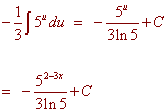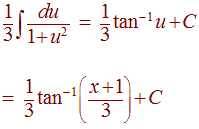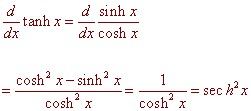Name
MATH 106
PRACTICE
MIDTERM 1
Please work out each of the given
problems. Credit will be based on
the steps that you show towards the final answer.
Show your work.
PROBLEM 1 Please answer the following true or false. If false, explain why or provide a counter example. If true, explain why or state the proper theorem.
A) Suppose that f(x) and g(x) are differentiable inverse functions, and f '(2) = 3. Then g'(2) = 1/3.
False. It would be true if we said that g'(f(2)) = 1/3.
B) If f is a differentiable function such that both f and f ' are positive for all x, then g(x) = ln(f(x)) is increasing for all values of x.
f '(x)
g '(x)
=
f(x)
is positive if both f ' and f are positive
PROBLEM 2 Calculate the derivatives of the following functions.A)
d
(2x)1-x
dx
Solution
(2x)1-x = e(1 - x)ln(2x)
Now use the chain and product rules. The derivative of
(1 - x)ln(2x)
is
(1 - x)(1/x) - ln(2x) = 1/x - 1 - ln(2x)
Hence the derivative of
e(1 - x)ln(2x)
is
[1/x - 1 - ln(2x)](2x)1-x
B) d
eln(sin
x)
dx
First use the inverse property of e and ln to get
eln(sin x) = sin x
Now the derivative is simply
cos x
C)
d 23t
dx t
Solution
We use the quotient rule to get
t(23t)' -23t
t2
Now use the chain rule and the fact that
bx ' = bx ln b
to get
3t ln2 (23t) - 23t
t2
dx
Solution
We use the chain rule for the first part and the product rule for the second part to get

PROBLEM 3 Find the following integrals
A)
![]()
Solution
Let
u = 1 - x du = - dx x = 1 - u

B)
Solution
Let
u = 2 - 3x du = -3 dx
The substitution produces

C) ![]()
Solution
Let
u = 4 - x2 du = -2x dx
![]()
D)
Solution
We first
complete the square
x2 + 2x + 10 = x2 + 2x + 1 - 1 + 10
= (x + 1)2 + 9
Now integrate

u2 = (x + 1)2 / 9
We get

PROBLEM 4 Let f(x) = 2x3 + 4x + 5
A. Prove
that f(x) has an inverse.
Solution
We calculate
f
'(x) = 6x2 + 4
which is always positive, hence f(x) has an
inverse.
dx
Solution
We use the inverse formula
d
1
f -1(11)
=
dx
f '(f -1(11))
Since
f(1) = 11
We have
f -1(11) = 1
and
f '(1) = 6(1)2 + 4 = 10
Hence
d
1
1
f -1(11)
=
=
dx
f '(f -1(11))
10
PROBLEM 5
Show that d
tanh x = sech2
x
dx

Extra Credit: Write
down one thing that your instructor can do to make the class better and one
thing that you do not want changed with the class.
Back to the Math Department Home Page
Questions, Comments and Suggestions:
Email: greenl@ltcc.edu